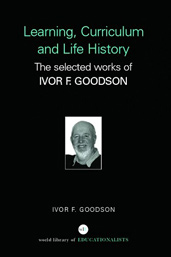Learning, Curriculum and Life Politics: the selected works of Ivor F. Goodson
On Curriculum Form
In this matrix a range of possible curriculum combinations can be discerned. For instance, Option A in Figure 3 represents a situation, which prevailed for a long time in Britain, in which the elite alone received schooling of an academic nature. Combining A with B provides recontextualised academic schooling for the higher orders and contextualised practical training for the lower orders - in effect a hierarchical and stratified ‘caste curriculum’.
Attempts to reform curricula can be top-down (A to C) or bottom-up (B to D). In the top-down model, academic decontextualised knowledge is distilled and made available to a wider audience (many of the curriculum reforms in the 1960s were of this sort). In the bottom-up model, contextualised knowledge is used as a vehicle for more general theoretical education (as was the case with the Science of Common Things).
A Pattern of Structuration
The matrix of curricular forms illustrates a range of potential patterns for programming, developing and reforming curricula. But behind the apparent flexibility lie established patterns of finances and resources. In Britain these patterns were established mostly in the period 1904-1917. Their establishment and continuance into the late 20th century provide us with a historical instance of the social and political processes that underpin school subjects.
The 1904 Secondary Regulation, list and prioritise the subjects that are suitable for education in the secondary grammar schools. The subjects were largely those that have come to be seen as ‘academic’ subjects, a view confirmed and consolidated by their enshrinement in the School Certificate examinations launched in 1917.
From 1917 onwards, examination subjects, the ‘academic’ subjects, inherited the preferential treatment in finance and resources directed at the grammar schools. It should be noted that the examination system itself had developed for a comparable clientele. The foundation of these examinations in 1858 "was the universities' response to petitions that they should help in the development of 'schools for the middle classes'" (University of Cambridge 1958, p. 1). (The genesis of examinations and their subsequent centrality in the structure of the educational systems are a particularly good example of the importance of historical factors for those developing theories about curriculum and schooling.)
